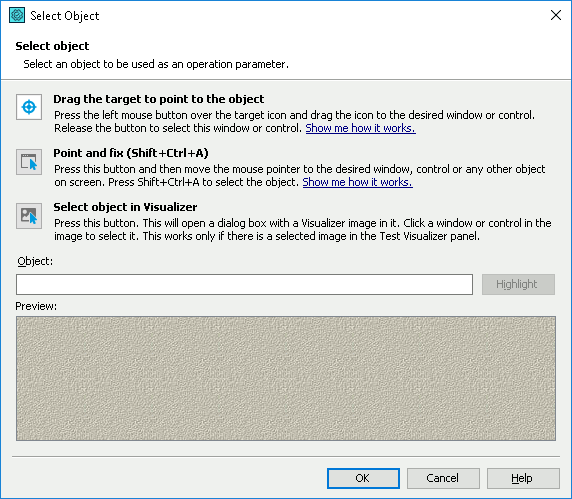The Select Object dialog is used to specify an object that will be used as a parameter of a keyword test operation.
It is displayed when you do any of the following:
-
Press the ellipsis button in the Value field of the Edit Parameter dialog when Mode is set to Onscreen Object.
-
Press Select On-screen Object in the Edit Expression, Specify Object, Call Object Method or Run Code Snippet dialog.

You can specify the object in one of the following ways:
Note for mobile testing: To specify an object in a mobile application, select the object on the Mobile Screen (make sure the Mobile Screen window is not hidden before selecting the object). Also note that the application under test and the mobile device, where the application is running, must be prepared for testing in order for TestComplete to be able to access the application’s objects.
-
Pick the object with the target glyph
Drag the target glyph (
 ) to the desired onscreen object and drop it once a red frame appears around the object.
) to the desired onscreen object and drop it once a red frame appears around the object.To select an object in a mobile application, drag the target glyph to the desired object on the Mobile Screen (see Select an Object on the Mobile Screen).
-
Point to the object and fix
Click the
 button, activate the desired object in the application and position the mouse pointer over it. When a red frame appears around the object, press the Select object shortcut, Shift+Ctrl+A. (The shortcut can be changed in the Global Shortcuts options.)
button, activate the desired object in the application and position the mouse pointer over it. When a red frame appears around the object, press the Select object shortcut, Shift+Ctrl+A. (The shortcut can be changed in the Global Shortcuts options.)To select an object in a mobile application, move the mouse pointer over the desired object on the Mobile Screen (see Select an Object on the Mobile Screen).
-
Select the object from Test Visualizer

This functionality is available only: -
for desktop and web applications,
-
if the Visualizer images contain object information, that is, they were captured in the Capture tested object properties mode.
Click the
 button. The Visualizer Frame window will open and display the image (frame) that is currently selected in the Test Visualizer panel. Select the desired object on the image.
button. The Visualizer Frame window will open and display the image (frame) that is currently selected in the Test Visualizer panel. Select the desired object on the image. -
-
Enter the object name manually
Enter the full name, full mapped name or alias of the desired object in the Object box and press Enter.
Tips on selecting objects:
-
You may find the second technique more convenient than using the target icon, because you can manipulate applications before actually selecting an object. For example, you can open the tested application window containing the desired control and so on. Unlike using the target icon, with this technique, you can point to popup windows, tooltips, and other objects that are hidden in the application when being inactive.
-
To select a non-onscreen object, such as a
process, enter the object name manually. -
Instead of selecting the object, you can copy its name from the Object Browser, keyword test, or script code beforehand and paste it into the Object box.
-
Despite the way you specify the object name, you can change or correct it directly in the Object box.
If the Map object names automatically setting is enabled, TestComplete automatically maps the specified object to a custom name (if it does not have one yet) and displays this name in the Object box. Otherwise, TestComplete uses the default object name.
The image of the selected object is displayed in the Preview area. To highlight the appropriate object on screen, click Highlight.
To use the specified object’s name and continue the operation you were performing, click OK. To close the dialog without performing any actions, press Cancel.
See Also
Operation Reference
Selecting Objects for Keyword Test Operations
About Mobile Screen Window
Selecting an Object on the Mobile Screen (Android Testing)
Select an Object on the Mobile Screen (iOS Testing)
Instrumenting Android Applications - Overview
Preparing iOS Applications
Testing Mobile Applications
